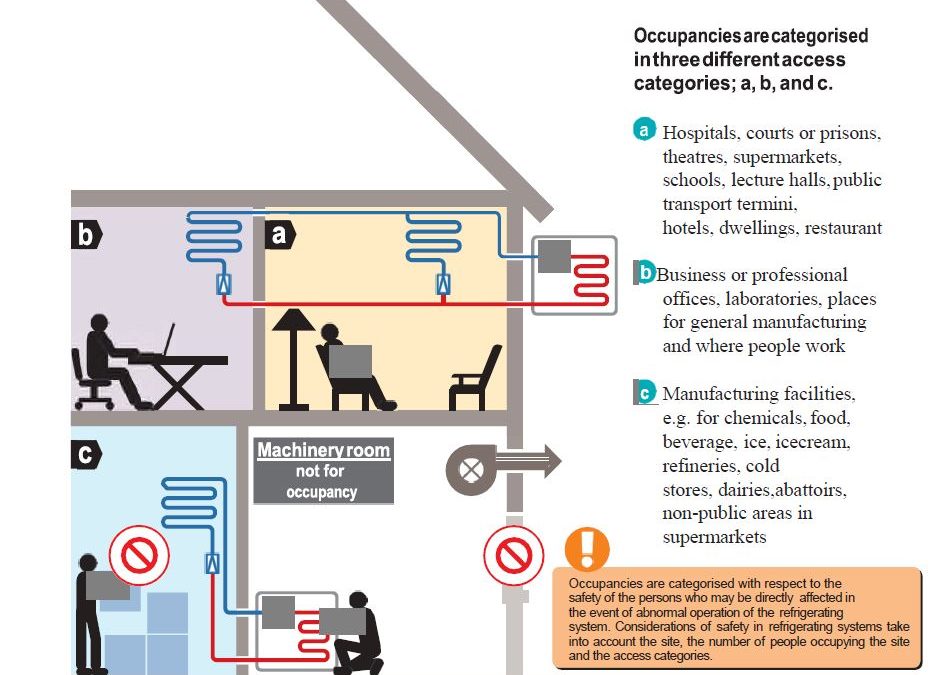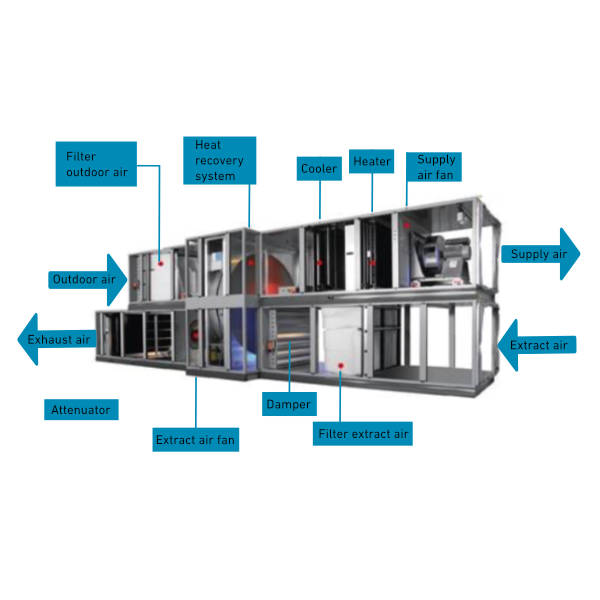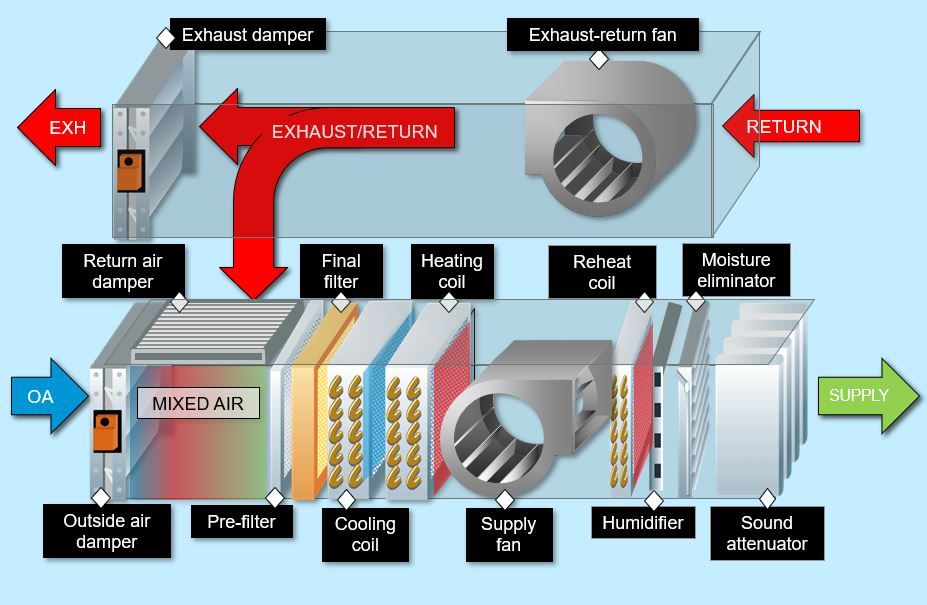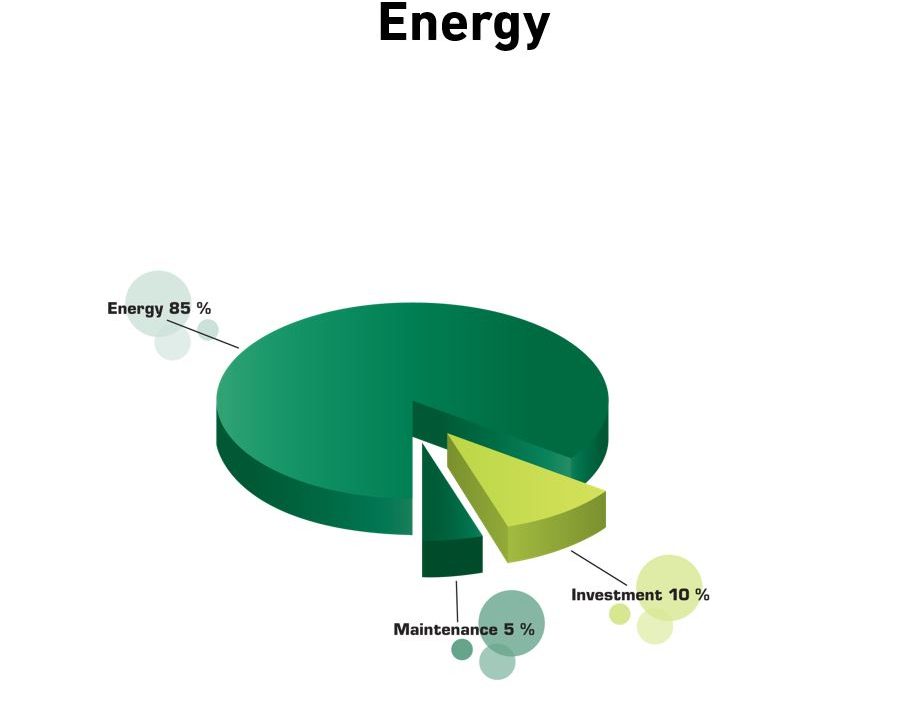EN 378 Guide
What is EN378?
Publication taken from AREA aisbl
Refrigerating Systems and heat pumps – Safety and environmental requirements
European Standard EN 378 guide is to those responsible for refrigeration systems and heat pumps, and especially to refrigeration, air conditioning and heat pump contractors.
EN 378 relates to safety and environmental requirements in the design, manufacture, construction, installation, operation, maintenance, repair and disposal of refrigerating systems and appliances regarding local and global environments.
Global Warming
Refrigerants should be selected with due regard to their potential influence on the global environment (ODP, GWP) as well as their possible effects on the local environment. Evaluation of the environmental performance requires a lifecycle approach. With regard to global climate change the Total Equivalent Warming Impact approach is generally used as the basis (see Annex B of EN
378 Part 1).
The total equivalent warming impact (TEWI) is a way of assessing global warming by combining the direct contribution of refrigerant emissions into the atmosphere with the indirect contribution of the carbon dioxide and other gas emissions resulting from the energy required to operate the refrigerating system over its operational life.
Many factors influence the environmental impact of refrigerating systems, such as:
- Location of the system
- Energy efficiency of the components
- The type of refrigerant
- Service frequency
- Refrigerant leakage rate
- Minimization of heat load
- Control methods
Important points regarding natural and low-GWP refrigerants:
Refrigerant with high operating pressure
- R744 (CO2, Carbon Dioxide) (Safety class A1-refrigerant) The high operating pressure will often make these refrigerating systems classified as Category IV in the Pressure Equipment Directive (PED). This category sets the strictest requirements for CE-marking of refrigerating system assemblies.
- Where a release to atmosphere would bring the refrigerant condition to or below the triple point, the refrigerant may solidify. The arrangement of pressure relief devices and associated pipes shall therefore be designed to prevent any blockage of the refrigerant flow.
- Carbon Dioxide is heavier than air, so CO2-detectors should not be placed on the ceiling or high on the wall, but near the floor. This factor also applies to emergency ventilation systems.
Flammable refrigerants
Safety class A2L refrigerants (low flammability e.g. R32, R1234yf)
Safety class A3 refrigerants (higher flammability e.g. R290) - Refrigerating systems using flammable refrigerants shall be constructed so that any leaked refrigerant will not flow or stagnate so as to cause a fire or explosion hazard in areas within the equipment where components which could be a source of ignition are fitted.
- The flammability demands particular attention to charge limitations based on access categories, location classification of the refrigerating system and the Lower Flammability Limit (LFL) of the refrigerant.
- For proper placement of detectors and ventilation exhaust, one must establish whether the flammable refrigerant used is heavier or lighter than air.
Flammable and toxic refrigerant
Safety class B2L-refrigerant. R717 (ammonia)
- Refrigerating systems with ammonia demand particular attention to charge limitations because of the refrigerant’s properties of both flammability and toxicity. In EN 378 Part
1, one can calculate the maximumrefrigerant charge based on flammability or toxicity, and the lowest of these will apply as the upper limit. - In addition to fire and personal protection requirements detailed in EN 378 Part 3, it is important to draw attention to the danger of panic that often follows an unexpected leakage of ammonia, largely due to the fact that it is very detectible by smell at extremely low and non-harmful concentrations.
- Ammonia gas is generally lighter than air, so detectors should be placed on the ceiling or high on the wall. This factor also applies to emergency ventilation systems.
- EN 378 also covers requirements for safety measures for leakage of ammonia in the liquid phase.
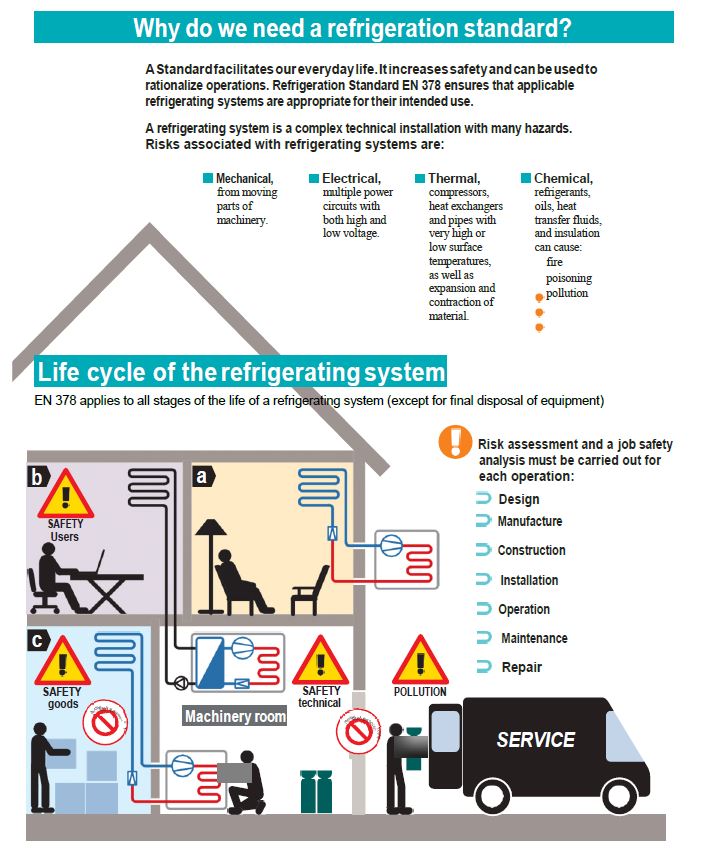
EN 378 covers most types and sizes of refrigerating systems
EN 378 applies to:
a) refrigerating systems (which includes heat pumps), stationary or mobile, of all sizes
b) secondary cooling or heating systems;
c) the location of the refrigerating systems;
d) Parts replaced and components added to existing refrigerating systems after publication of EN
378 if they are not identical in function and capacity;
e) new refrigerating systems,
f) extensions or modifications of existing systems,
g) existing stationary systems being transferred to and operated on another site.
h) the conversion of a system to another refrigerant type.
EN 378 does not apply to:
a) refrigerating systems and heat pumps which weremanufactured before the date of publication
of EN 378
b) Systems using refrigerants other than those listed in Annex E of EN 378 Part 1
c) vehicle air conditioning systems covered by a specific product standard (e.g. ISO 13043)
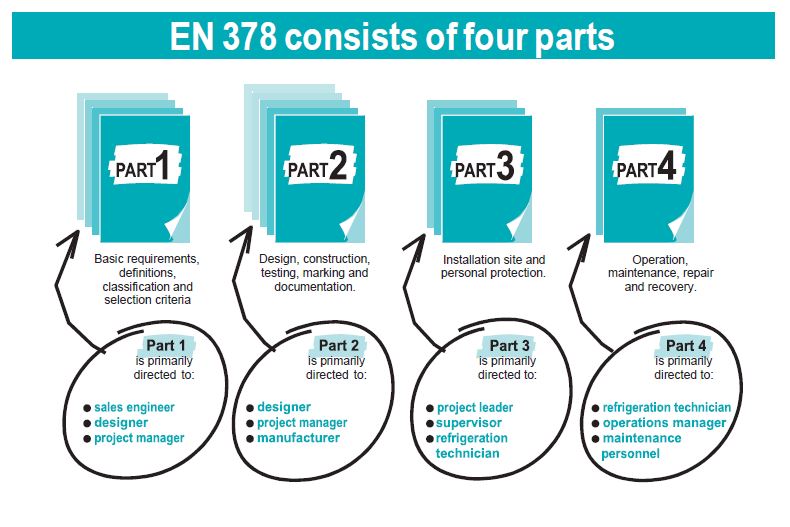
Part 1, 2, 3, and 4 are intended for different roles

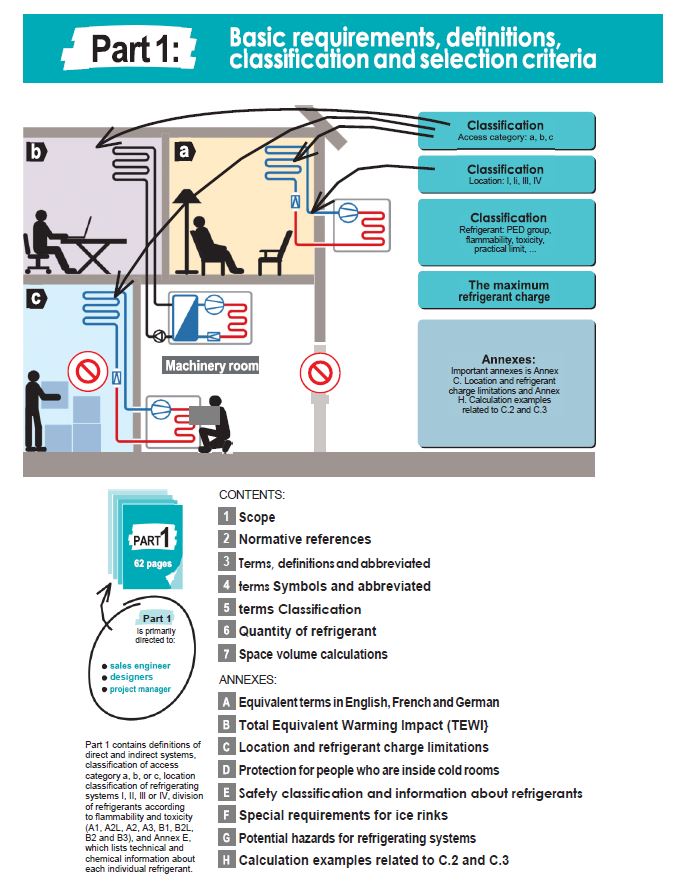
Clause 5.1 Access categories
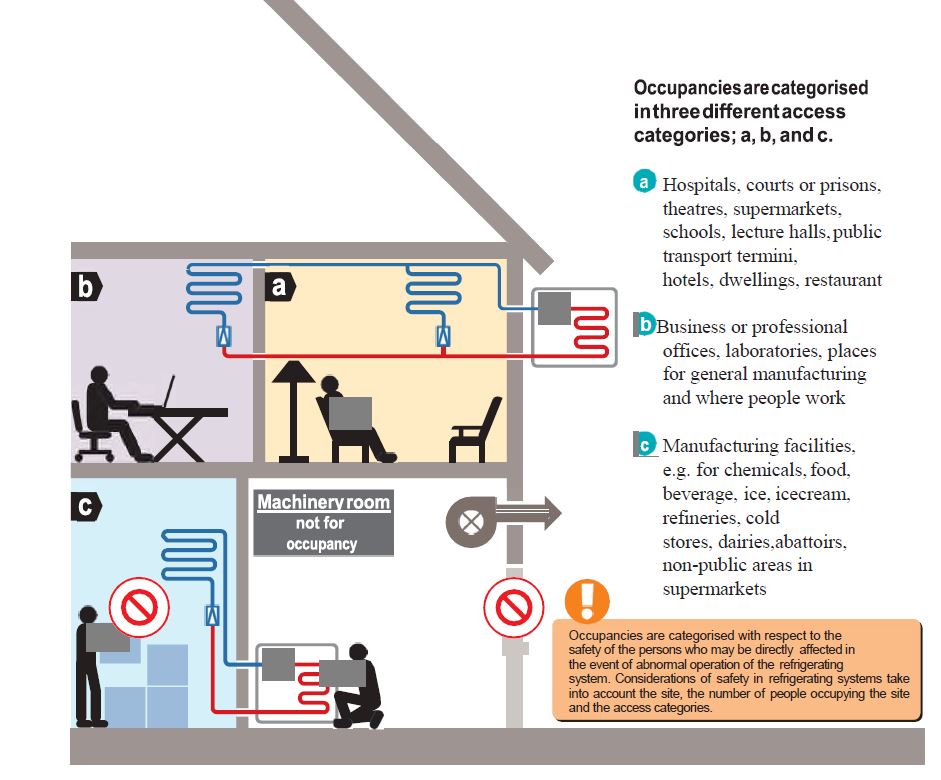
Clause 5.3 Location classification of refrigerating systems
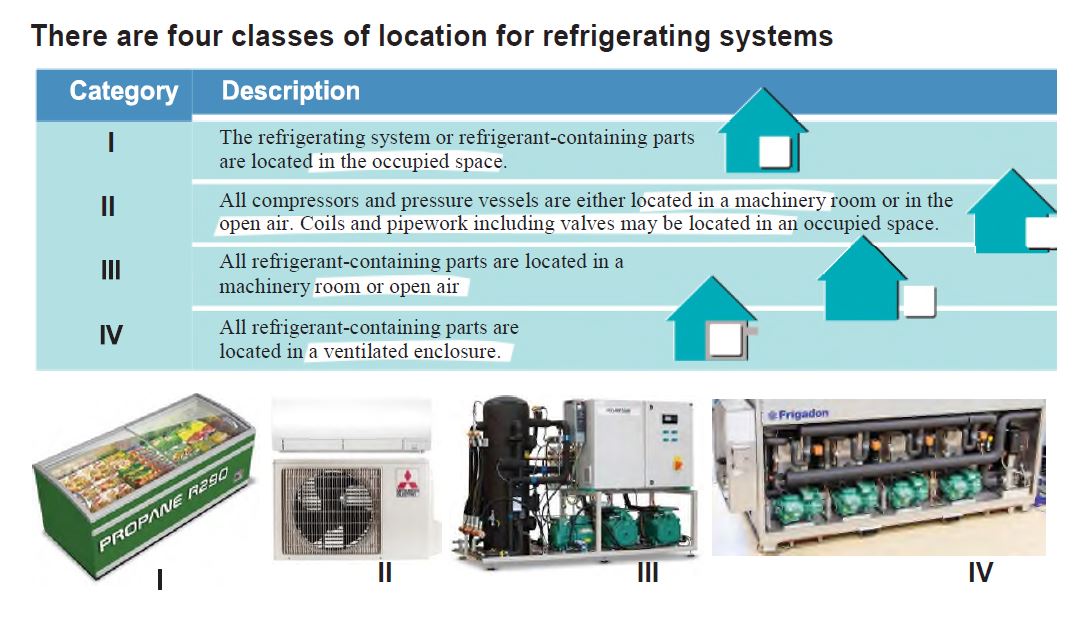
EN378,Part1, AnnexC-Refrigerant charge limit requirements
The most important parameters for determining the maximum refrigerant charge are the flammability of the refrigerant and/or toxicity, location classification of refrigerating systems and access category.
For Al and A2L refrigerants, there is also a possibility to increase the maximum refrigerant charge if additional safety measures are implemented (e.g. natural or mechanical ventilation, safety shut-off valves and safety alarm in conjunction with a gas detection device, etc.). See Clause C.3.
Maximum limit refrigerant charge calculation:
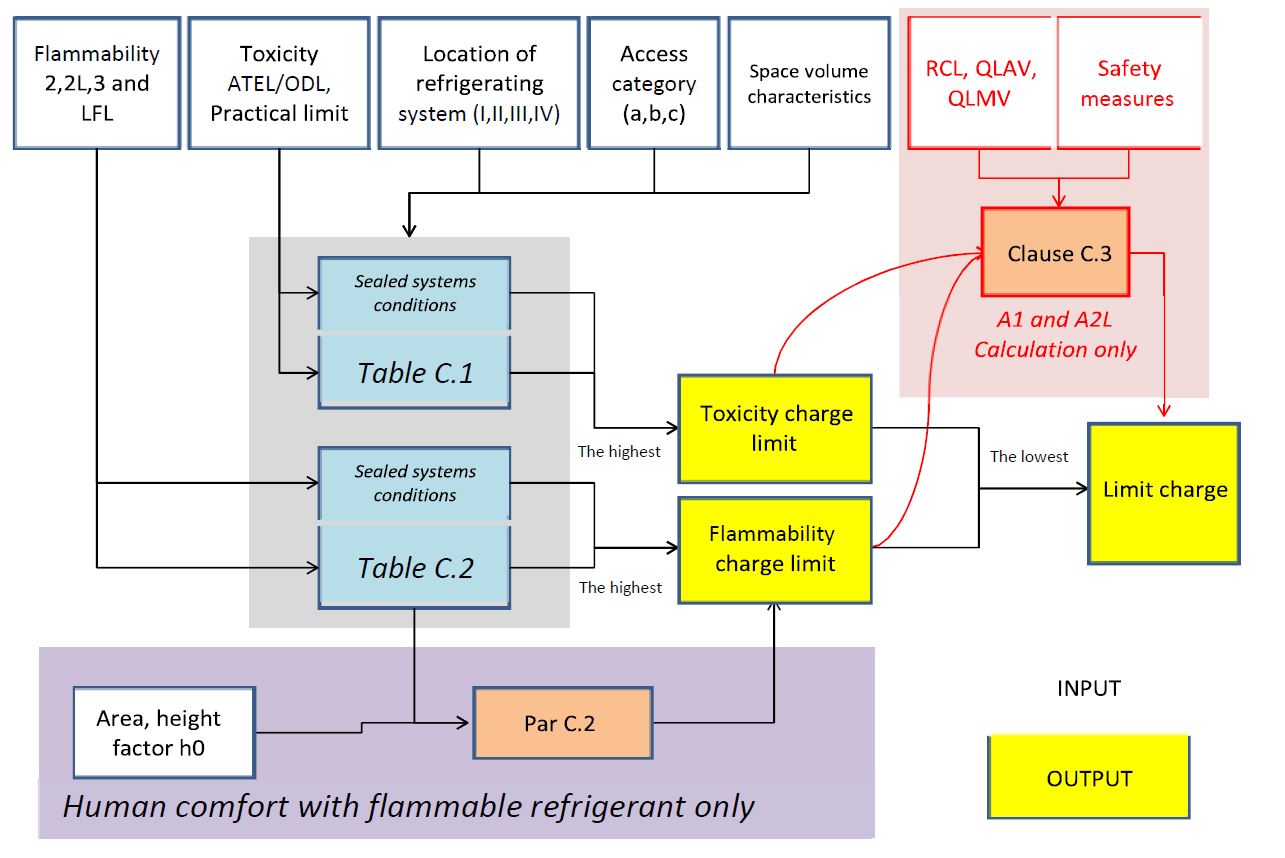
See page 13 , information about refrigerants, and page 14, examples of Table C.1 and Table C.2.
Annex E – Safety classification and information about refrigerants
- Annex E provides information about chemical name, chemical formula, safety class, PED fluid group, practical limit, acute-exposure toxicity limit (ATEL) or oxygen deprivation limit (ODL), lower flammability limit (LFL), and other information necessary to calculate the maximum refrigerant charge.

Example of table of refrigerants in Annex E:

NA signifies not applicable. ND signifies not determined. NF signifies non-flammable.
a. The vapour density, molecular mass, normal boiling point, ODP and GWP (AR5) are not part of
EN 378 and are provided for information purposes only.
b. The preferred chemical name is followed by the popular name in parentheses.
c. Sublimation temperature. Triple point is −56,6 °C at 5,2 bar.
d. Determined according to 5.2 of this standard.
e. Adopted under the Montreal Protocol.
f. Data from IPCC Assessment Report V (AR5); for HCs which are not included in AR5, data from FGas
regulation N° 517/2014.
g. Acute-Toxicity Exposure Limit (ATEL) or Oxygen Deprivation Limit (ODL), whichever is lower values
taken from ISO 817.
h. Lower Flammability Limit.
i. Practical limit values are grandfathered according to 5.2.
j. ATEL/ODL values are changed in comparison to EN 378–1:2008+A2:2012 according to data from ISO 817.
k. No cardiac NOEL value available, value determined according to ISO 817.
l. Data from European F-Gas regulation N° 517/2014; for CFCs and for HCFCs which are not included in F-Gas regulation N° 517/2014, data from IPCC assessment report IV.
m. PED = Pressure Equipment Directive 2014/68/EU.
n. According to the test conditions in ISO 817, the refrigerant is classed as 2L, however the PED fluid group is 2, based on CLP Regulation (EC) 1272/2008.
One table based on toxicity, one table based on flammability
- Refrigerant charge limits shall be calculated according to Table C.1 and Table C.2 depending on the toxicity and/or the flammability of the refrigerant.
- Where more restrictive national or regional regulations exist, they take precedence over the charge limit requirements of EN 378.
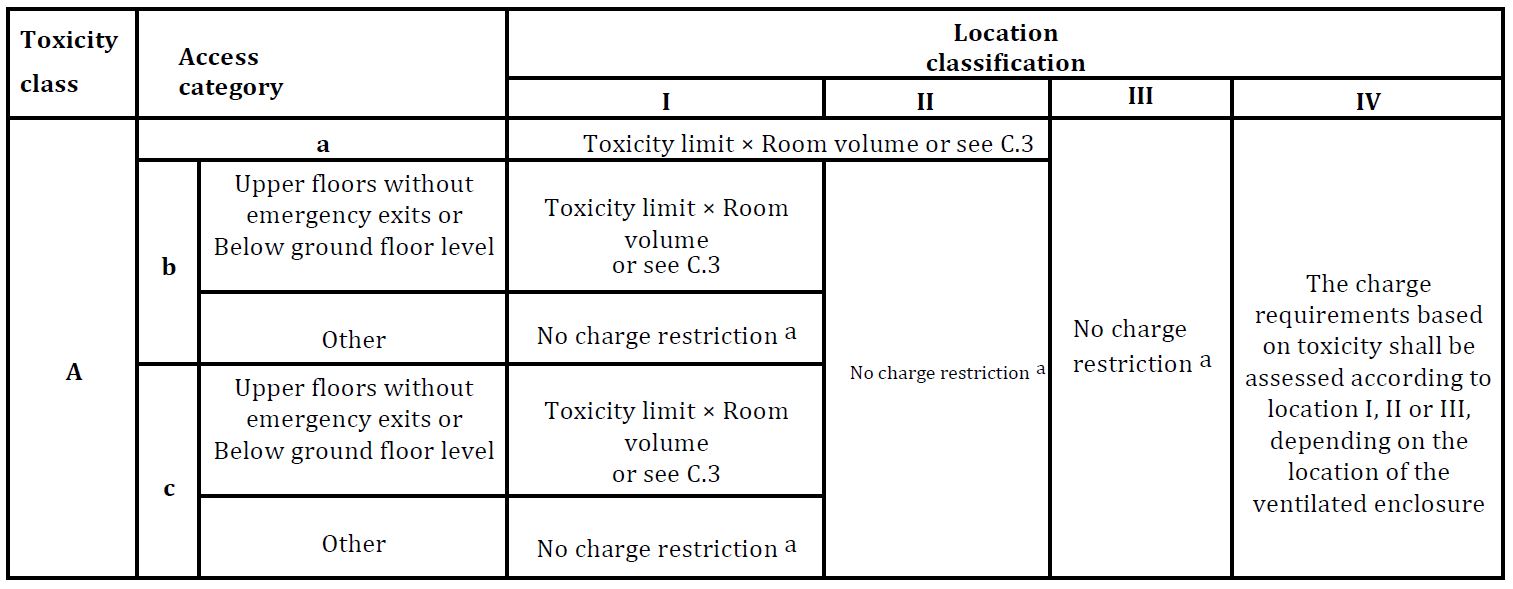
Example of charge limit requirements for refrigerating systems based on toxicity (From Table C.1)
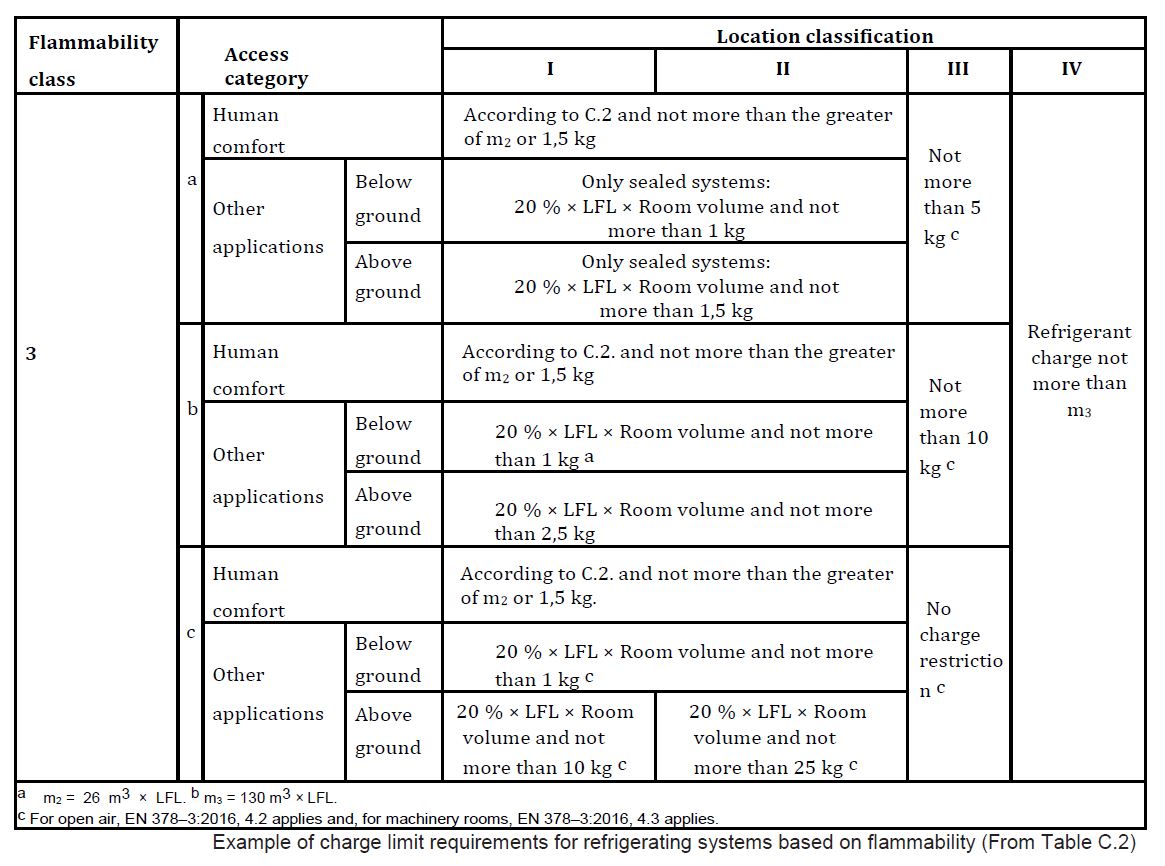
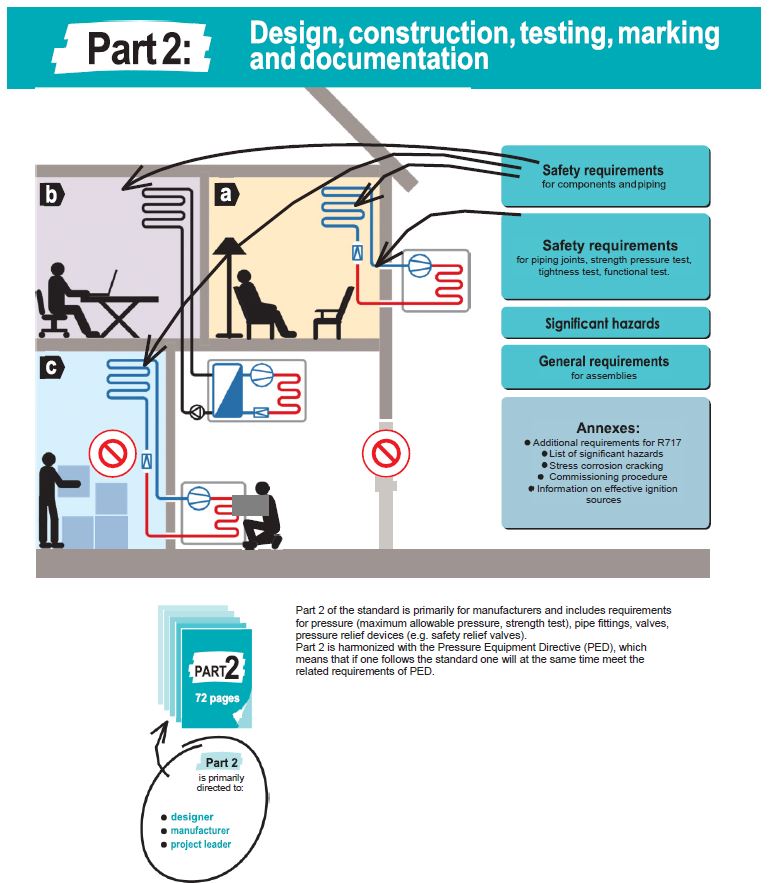
Design, construction, testing, marking and documentation
CONTENT:
- Scope
- Normative references
- Terms, definitions and abbreviated terms
- Significant hazards
- Safety requirements
Requirements for assemblies
ANNEXES:
A. Additional requirements for refrigerating systems containing R717
B. Determination of category for components and refrigerating systemassemblies
C. Requirements for intrinsic safety test List of significant hazards
D. List of significant hazards
E. Assessment of assemblies for compliance with directive 2014/68/EU
F. Examples for arrangement of pressure relief devices in refrigerating systems
G. Checklist for external visual inspection of the installation
H. Stress Corrosion Cracking
I. Leak simulation test for A2L,A2,A3,B2L, B2, B3 refrigerants
J. Commissioning procedure
K. In Information on effective ignition sources
ZARelationship betweenthis EuropeanStandardand the Essential Requirements of EU Directive
2014/68/EU (Pressure Equipment Directive)
ZBRelationship betweenthis EuropeanStandardand the Essential Requirements of EU Directive
2006/42/EU (Machinery Directive)

PED:Determination of category for equipment
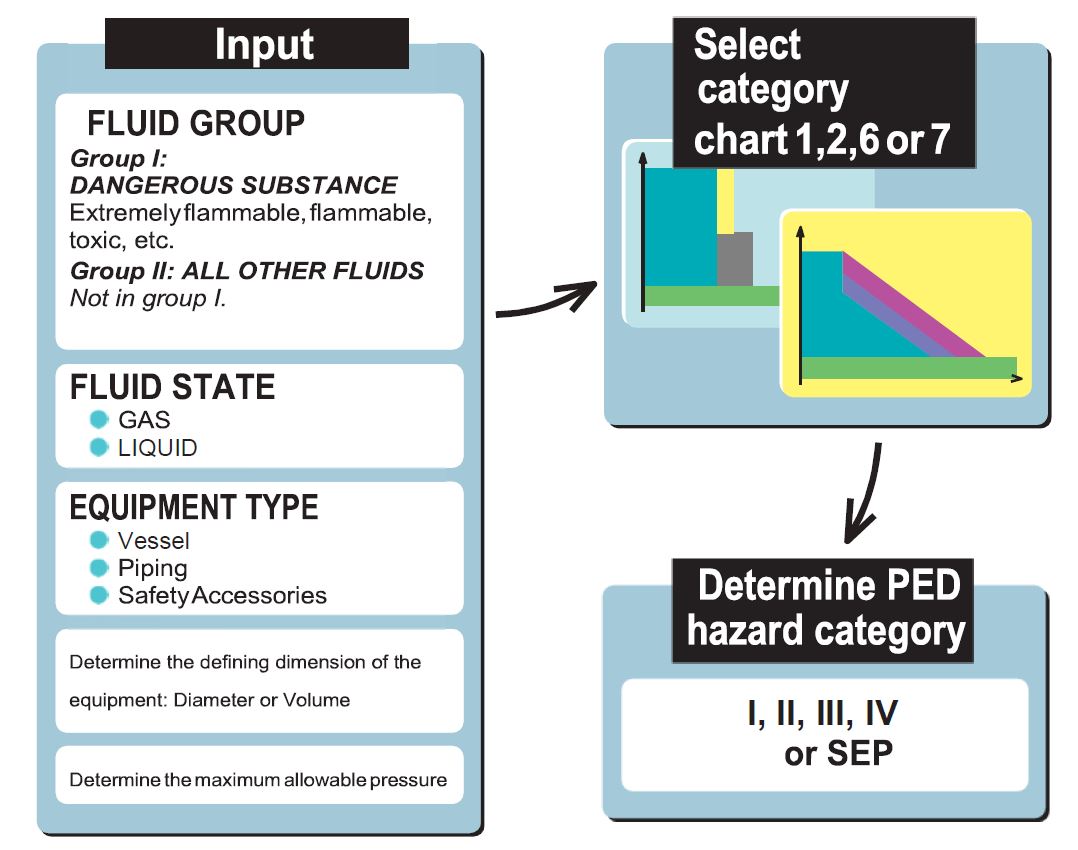
Once it is determined that the equipment is covered by the PED, the classification has 6 steps:
1. Determine the type of pressure equipment being considered
2. Determine the state of the fluid in the equipment
3. Determine the hazard group of the fluid in the equipment
4. Select the appropriate hazard category chart
5. Determine the maximum allowable pressure and the defining dimension of the
equipment
6. Determine the PED hazard category

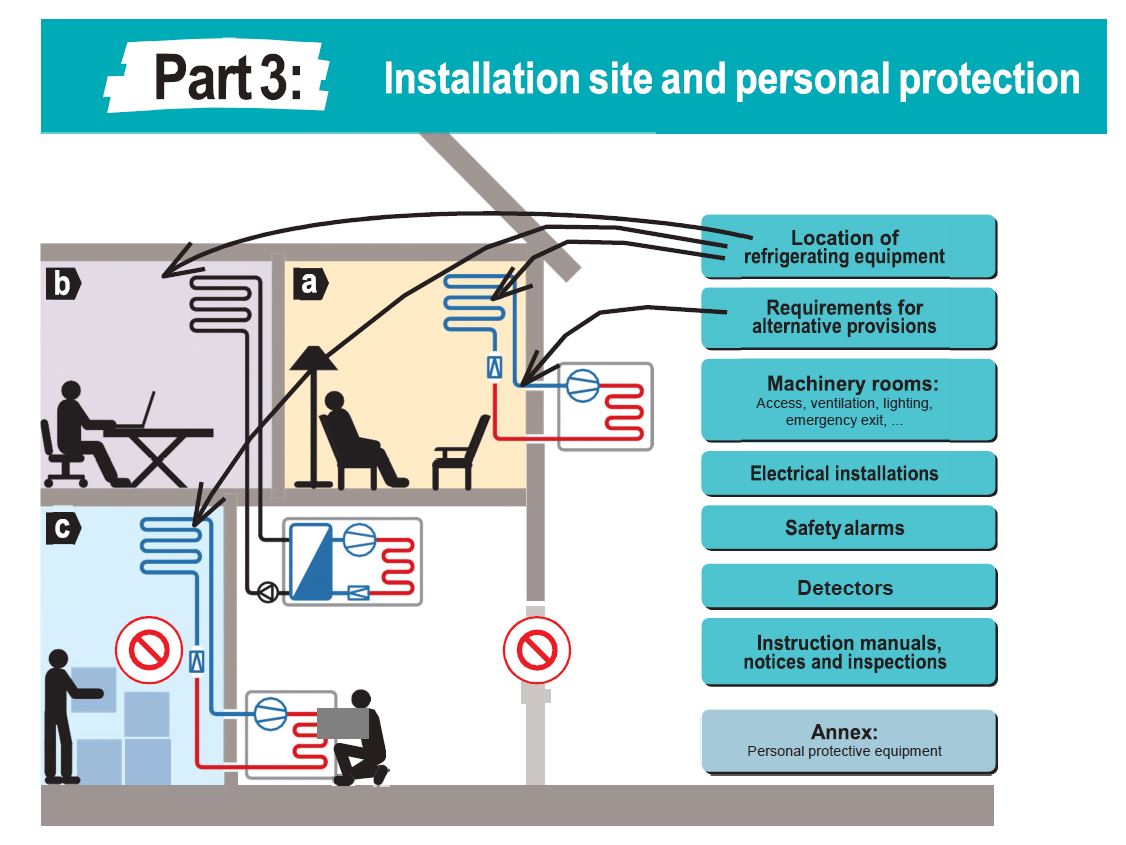
CONTENT:
- Scope
- Normative references
- Terms, definitions and abbreviated terms
- Location of refrigerating equipment
- Machinery rooms
- Requirements for alternative provisions
- Electrical installations
- Safety alarms
- Detectors
- Instruction manuals, notices and inspections
- Heat sources and temporary high temperatures at the site
APPENDIX:
A. Personal protective equipment
Clause 5 Machineryrooms
EN 378 distinguishes between machinery rooms intended to contain components of the refrigerating system and other equipment, and separate refrigeration machinery rooms intended to contain only components of the refrigerating system.
The advantage of a separate refrigeration machine room is the possibility to perform inspection, maintenance and repair, and even let an alarm close down the power supply to the refrigeration system only, without having to take into account any other equipment.
The many requirements for a machinery room to be in accordance with EN 378 are listed in Clause 5:
5.1. Access to machinery rooms
5.2. Venting fromor through the machinery room
5.3. Combustionequipmentandaircompressors
5.4. Open flame
5.5. Storage
5.6. Remote emergency switch
5.7. Exterior openings of the machinery room
5.8. Piping and ducting
5.9. Normal lighting
5.10. Emergency lighting
5.11. Dimensions and accessibility
5.12. Doors, walls andducts
5.13. Ventilation
5.14. Machinery rooms for groupsA2L,A2,A3, B2L, B2 and B3 refrigerants
Machinery rooms: Building requirements and personal safety
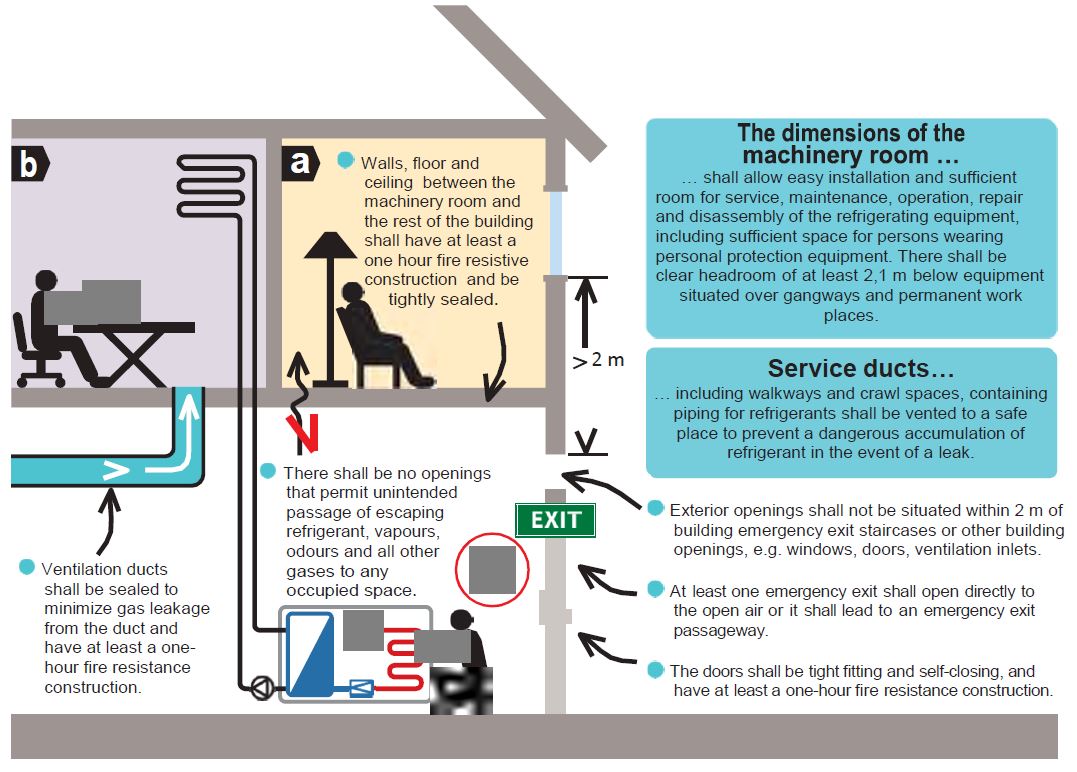

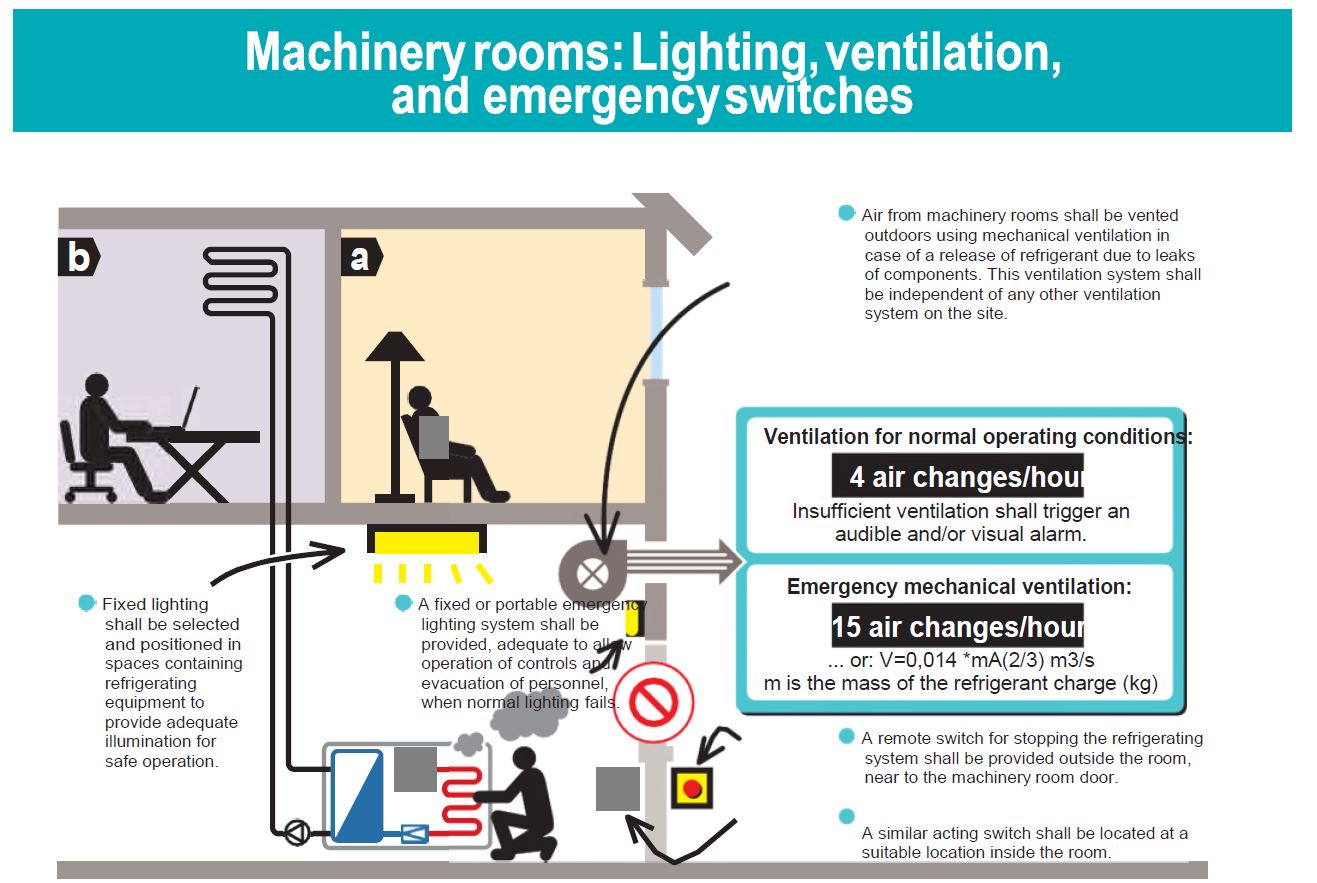
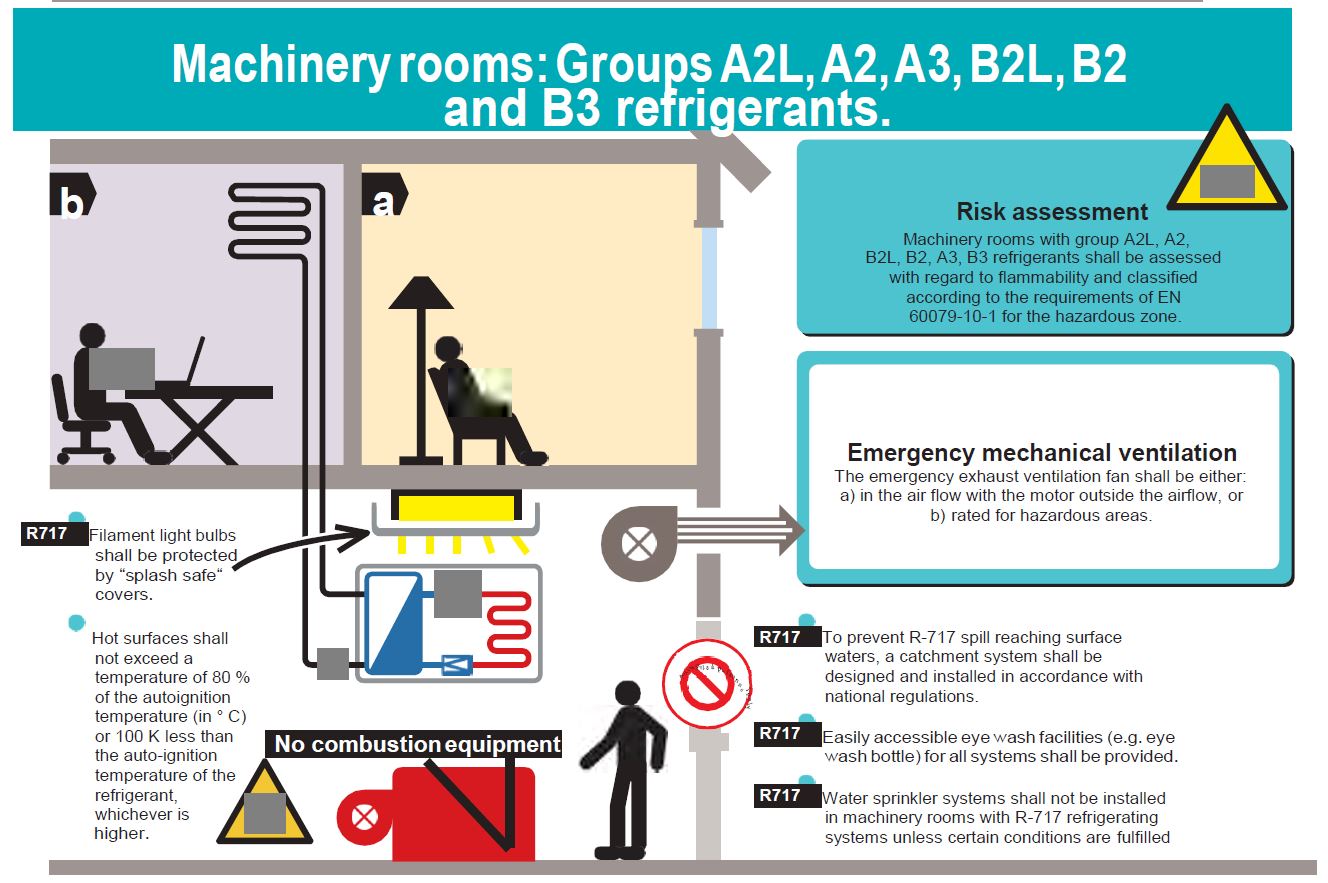
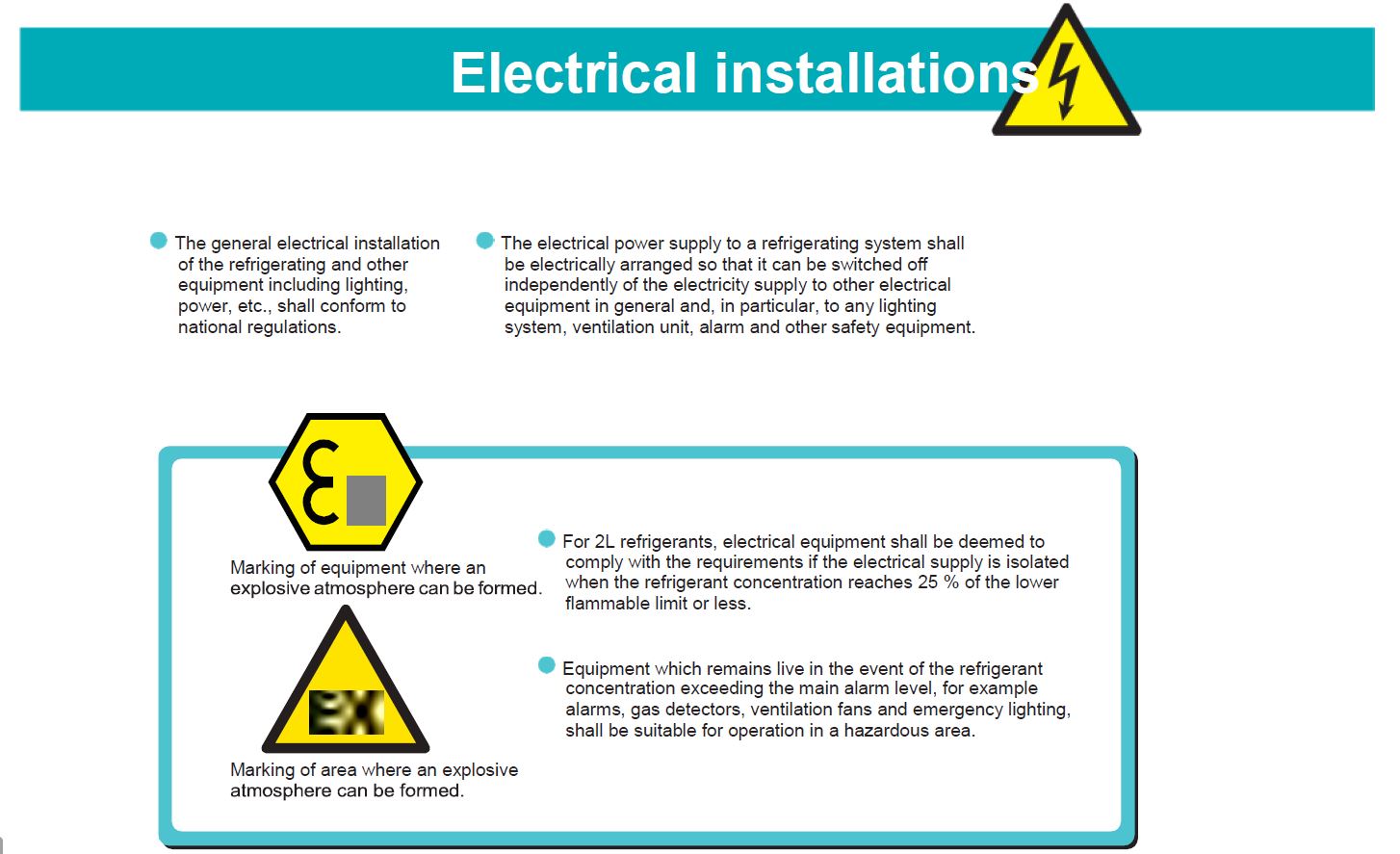
Alarms and detectors
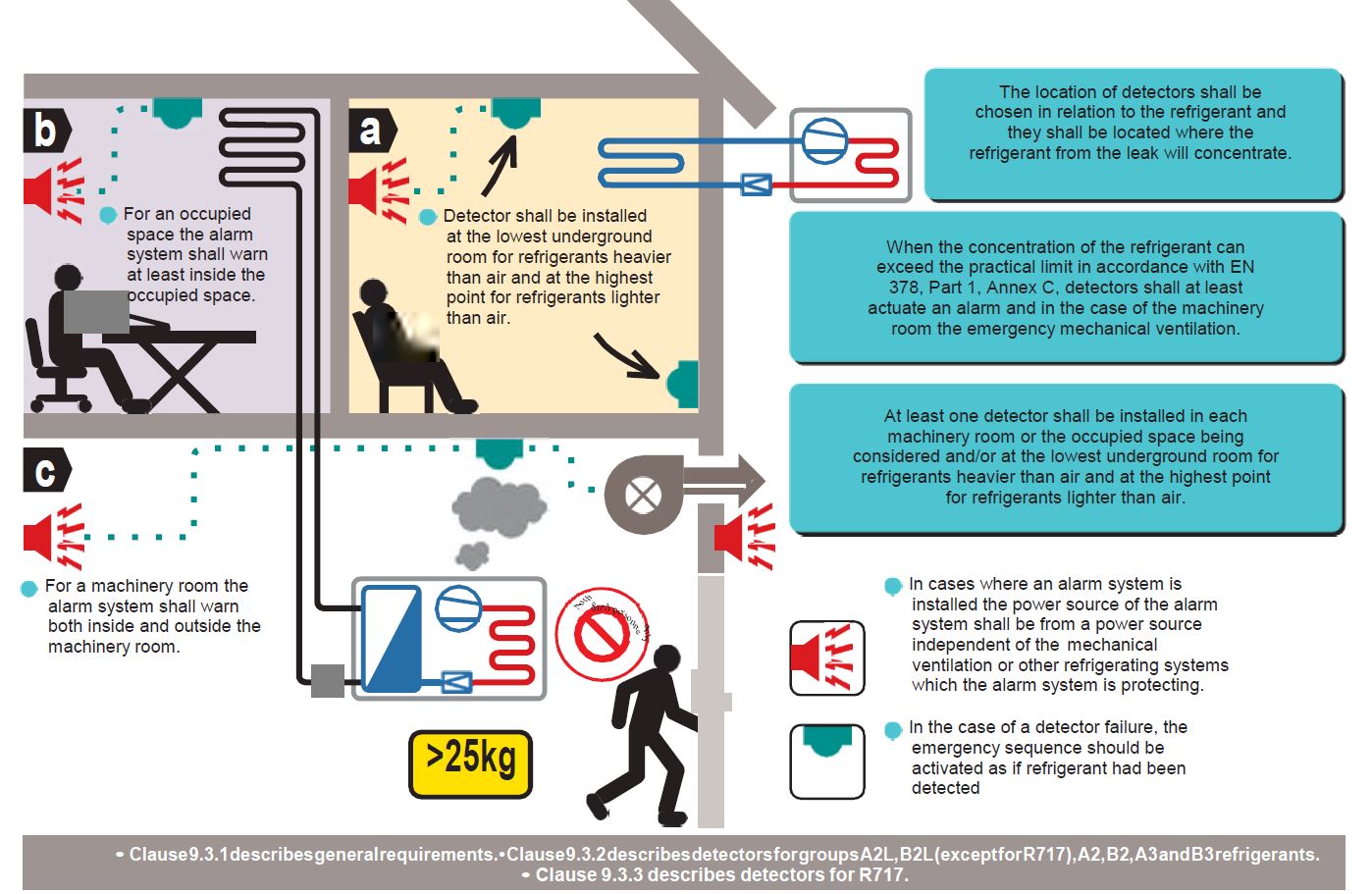
Instruction manuals, notices and inspections
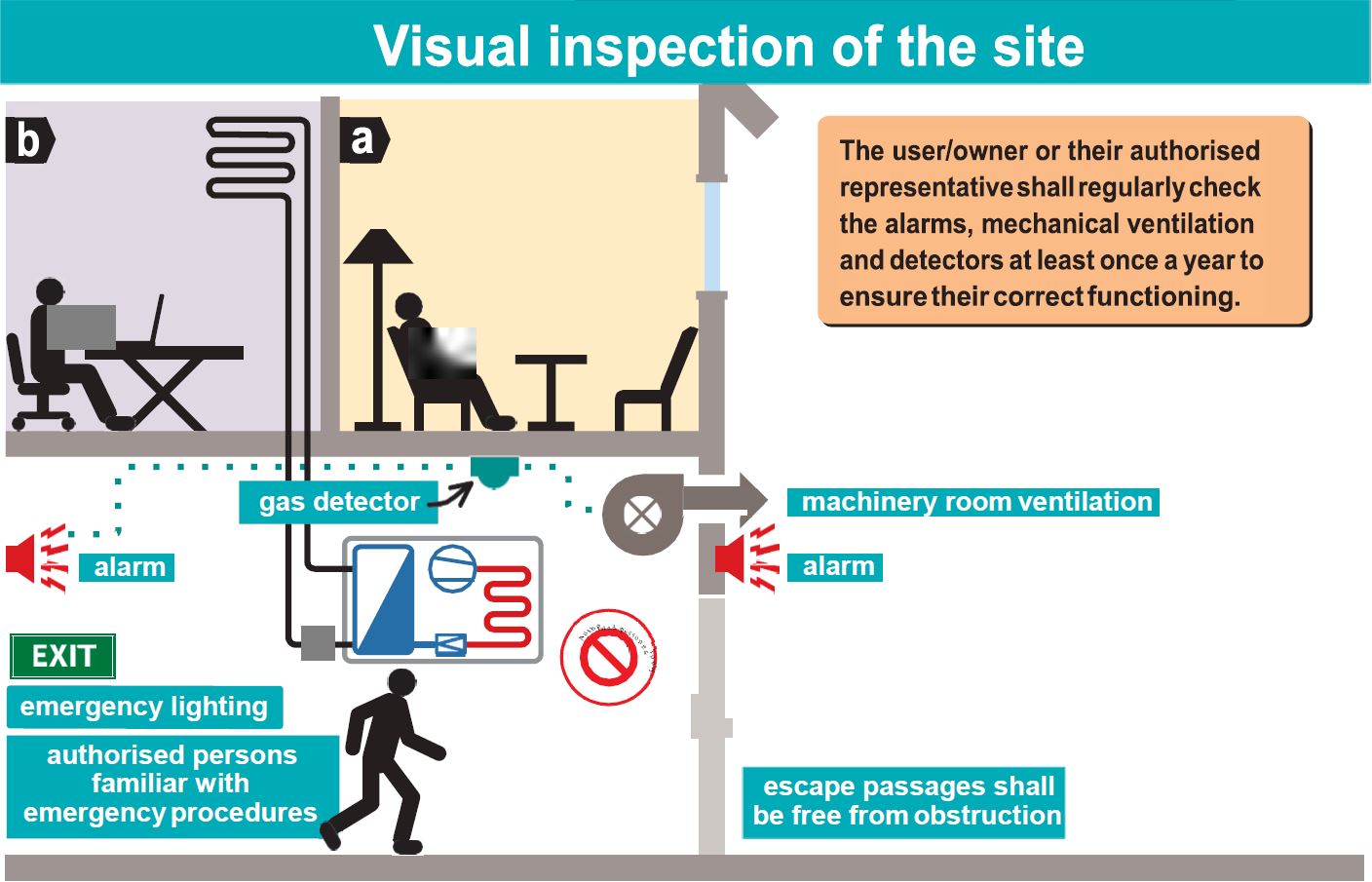
Location of refrigerating equipment
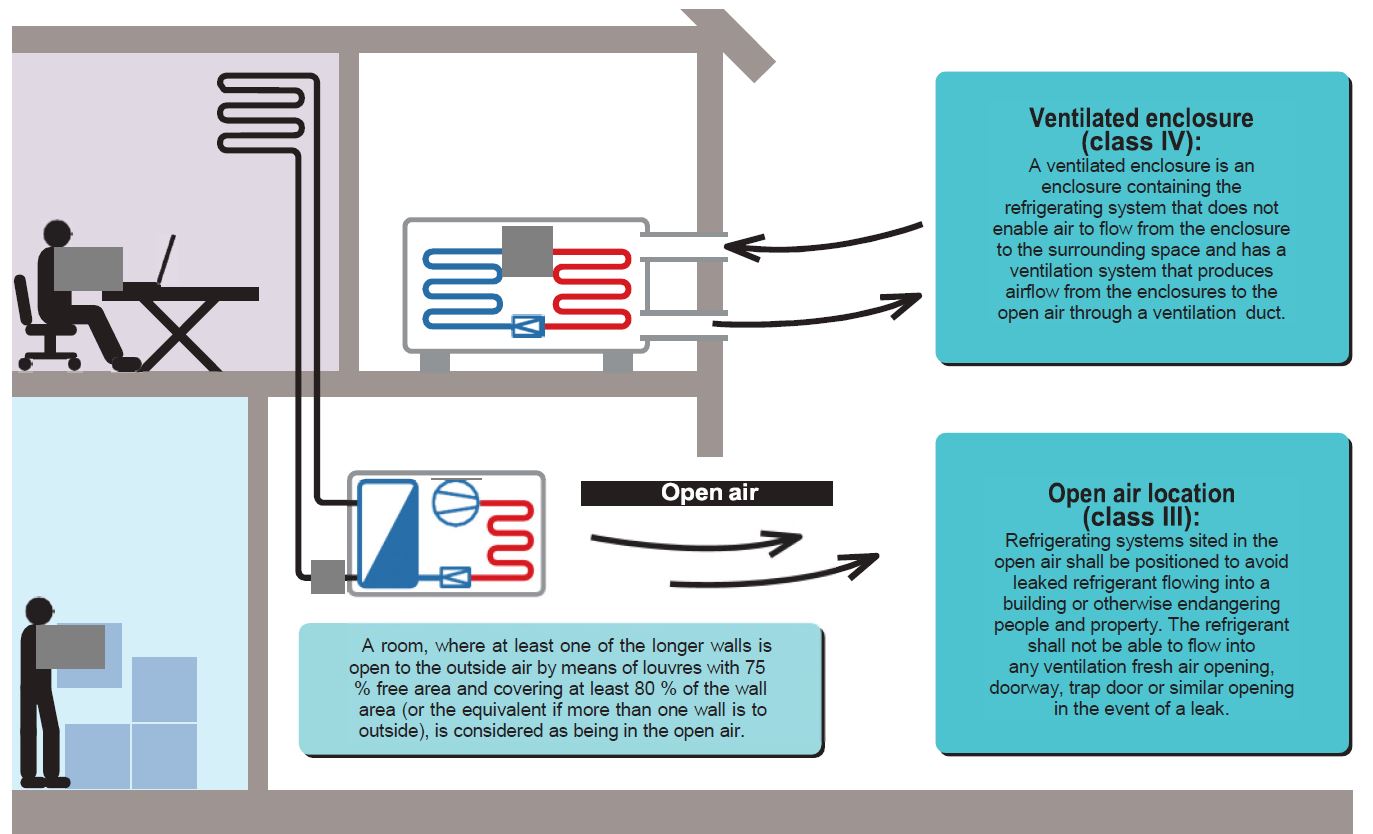
EN 378, Part 3,Clause 4, defines requirements and directions for location of refrigerating equipment.There are greater limitations for equipment located in occupied spaces than for amachinery room, open air or ventilated enclosure located within an occupied space.
EN 378, Part 1,Clause 5,defines access categories and refrigerating system classification.
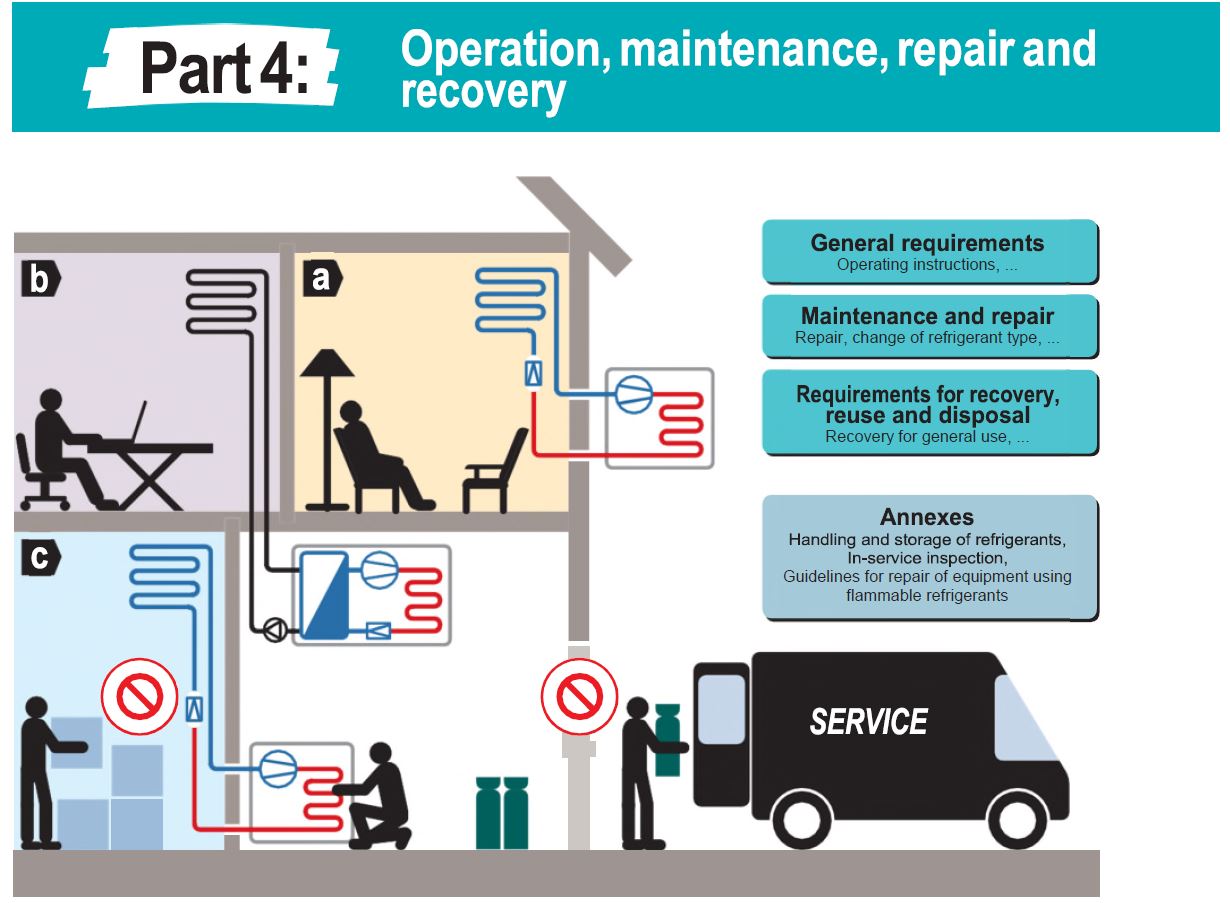
CONTENTS:
- Scope
- Normative references
- Terms, definitions and abbreviatedterms
- General requirements
- Maintenance and repair
- Requirements for recovery, reuse and disposal
ANNEXES:
A. Draining the oil from a refrigerating system
B. Guidespecificationforrecycledrefrigerant
C. Handling and storage of refrigerants
D. In-service inspection
E. Guidelinesfor repairofequipmentusingflammable refrigerants
Part 4 of the standard contains many useful tips for the refrigeration technician, such as Clause 5 ”Maintenance and repair”, and Appendix D ”In-service inspection”. The standard also emphasizes requirements for recycling, reuse and disposal of refrigerant.
Currently safe use of flammable refrigerants is emphasised. Therefore particular points from Appendix E are highlighted on the following page.
Annex E (informative)Guidelines for repairs of equipment using flammable refrigerants
The following is an extract from Annex E.
E.1 General requirements for equipment
Only competent persons that are trained in the use of flammable refrigerants are permitted to open equipment housings or to break into the refrigerant circuit.
E2.2 Repairs to sealed components
The relevant power feed should be switched off before the sealed components are opened. If it is not necessary to switch off the relevant electrical components for repair work, the concentration in the atmosphere in the area concerned should be monitored continuously in order to be able to warn people about a potentially dangerous situation.
E.3 Repairs to refrigerating system
The following procedure should be followed before working on the refrigerant circuit:
a) remove refrigerant (specify the residual pressure);
b) purge circuit with inert gas (e.g. nitrogen);
c) evacuate to a pressure of 0,3 (abs.) bar (or 0,03MPa);
d) purge again with inert gas (e.g. nitrogen);
e) open the circuit.
The area should be checked with an appropriate refrigerant detector prior to and during any hot work to make the technician aware of a potentially flammable atmosphere.
If compressors or compressor oils are to be removed, it should be ensured that it has been evacuated to an acceptable level to ensure that there is no flammable refrigerant remaining within the lubricant.
Only refrigerant recovery equipment designed for use with flammable refrigerants should be employed.
In the case of refrigerating systems with an indirect system, the heat-transfer fluid should be checked for the possible presence of refrigerant.
After any repair work, the safety devices, for example refrigerant detectors and mechanical ventilation systems, should be checked and the results recorded.
It should be ensured that any missing or illegible label on components of the refrigerant circuit is replaced.
Sources of ignition should not be used when searching for a refrigerant leak.
Annex E (informative)Guidelines for repairs of equipment using flammable refrigerants
- E.4 Requirements for the competentpersons
Maintenance and repair requiring the assistance of other skilled personnel should be carried out under the supervision of the person competent in the use of flammable refrigerants.Any person conducting servicing or maintenance on a system or associated parts of the equipment should be competent according to EN 13313.Persons working on refrigerating systems with flammable refrigerants should have competence in safety aspects of flammable refrigerant handling supported by evidence of appropriate training. This will include the following requirements - knowledge of legislation, regulations and standards relating to flammable refrigerants;
- detailed knowledge of and skill in handling flammable refrigerants, personal protective equipment, refrigerant leakage prevention, handling of cylinders,
charging, leak detection, recovery and disposal.

Legislation
EN 378 provides a means of proving conformity with some relevant European directives. Whileall four parts of the first edition (2000) were harmonised with European Directive
97/23/EC (The “Pressure Equipment Directive”) when the standard was revised in 2008 it was concluded that it was only appropriate to harmonise part 2 (“Design, construction,
testing, marking and documentation”) with the PED 2014/68/EU. EN 378 Part 2 was also harmonized at that time with European Directive 98/37/EC (The “Machinery Directive”).
Harmonisation means that, once the link between the directive and the standard has been cited in the Official Journal of the European Union and at least one member state has
implemented it as their national standard, compliance with specific clauses can be presumed to indicate conformity with the equivalent essential safety requirements of the directive.
EN 378 is not, however, a legal requirement in its own right. It is possible to install a system in compliance with all relevant regulations, including PED and MD, without following the
requirements of EN 378. It is also not a complete design guide for refrigerating systems.
It only addresses topics that are not fully covered elsewhere. For example it does not give complete guidance on electrical safety, only on aspects which are relevant to refrigeration and which are not adequately addressed elsewhere. It does not provide presumption of conformity with all relevant European directives, only those which are specifically mentioned inAnnex Z in each of the four parts. At present this means that conformity can only be presumed with respect to design, construction, testing, marking and documentation requirements for the PED and the MD, not for any other directives and not for any other aspects of the directives. In particular compliance with EN 378 gives no presumption of conformity with directive 99/92/EC (The “ATEXWorkplace” directive”) or directive 2006/95/EC (The “Low Voltage directive”).
Any system using a “dangerous substance” as defined in CLP Regulation is required to meet the requirements of those regulations. Following the requirements of EN 378 in full does not
provide a presumption of conformity with regard to flammability.
Below is listed a summary of relevant EU legislation, not intended to be a comprehensive guide to EU law:
- Machinery Directive (MD)
- Pressure Equipment Directive (PED)
- ATEX ‘Equipment’ Directive: equipment and protective systems intended for use in potentially explosive atmospheres
- ATEX ‘Workplace’ Directive: occupational health and safety in potentially explosive atmospheres
- CLP Regulation (for Classification, Labelling and Packaging)
- F-gas Regulation
- Low Voltage Directive (LVD)
- ADR Regulations for drivers: The European Agreement Concerning the International Carriage of Dangerous Goods by Road
* This section reprinted by kind permission of the Institute of Refrigeration UK
Publication taken from AREA aisbl
To find the complete and precise information, one should buy and read the complete EN 378 standard; this will be available from the National Standards organisation in any EU member state.




